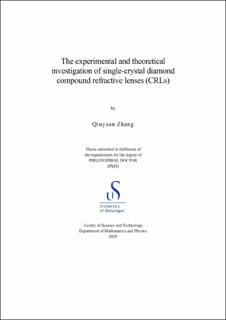| dc.contributor.advisor | Larsen, Helge Bøvik | |
| dc.contributor.advisor | Thorkildsen, Gunnar | |
| dc.contributor.author | Zhang, Qiuyuan | |
| dc.date.accessioned | 2020-06-12T09:42:13Z | |
| dc.date.available | 2020-06-12T09:42:13Z | |
| dc.date.issued | 2020-06 | |
| dc.identifier.citation | The experimental and theoretical investigation of single-crystal diamond compound refractive lenses (CRLs) by Qiuyuan Zhang. Stavanger : University of Stavanger, 2020 (PhD thesis UiS, no. 527) | en_US |
| dc.identifier.isbn | 978-82-7644-934-1 | |
| dc.identifier.issn | 1890-1387 | |
| dc.identifier.uri | https://hdl.handle.net/11250/2657862 | |
| dc.description.abstract | In the field of X-ray optics, compound refractive lenses (usually termed CRLs) function as a focusing device for hard X-rays and they are believed to possess a lot of prominent advantages over other focusing devices, such as the ease of alignment and compactness. Among all the potential materials used to fabricate CRLs, diamond stands out mainly due to its unique physical properties, e.g. strong thermal resistance and the ability to keep stable under extremely intense radiation (suitable for the even brighter next-generation X-ray source). When choosing between single-crystal and polycrystalline diamond, single-crystal diamond is favoured because it can avoid unwanted diffuse scattering induced by a sintered structure of polycrystalline diamond. Therefore, single-crystal diamond CRLs deserve a comprehensive analysis and are chosen as the subject of this thesis.
This PhD thesis consists of seven chapters. Chapter 1 reviews the history of two different kinds of X-ray sources, conventional X-ray tubes and synchrotron radiation (SR) light sources, including their principles of operation and the novel development of SR sources. Followed by that, Chapter 2 primarily focuses on X-ray optical devices and more emphasis is given to the X-ray beam conditioning devices (including both monochromators and X-ray focusing elements). Among a variety of focusing devices, CRLs turn out to be a huge success since the invention in 1990s and have been investigated in the aspect of focusing effect. However, a phenomenon that several significant intensity drops have been captured in the energy spectrum and are vividly termed as ‘glitch effects’, which call for a more rigorous treatment both experimentally and theoretically. Chapter 3 gives an overview of two experimental setups at BM31 (ESRF), France. As a good starting point, an energy scan was set up to investigate the influence of some possible experimental features on the glitches while sweeping through a range of photon energies, namely, the beam divergence, 𝜒𝜒-angle of the goniometer and different scanning positions. Besides, the energy spectrum also serves as a good reference for the second experiment, which was set up under almost the same configuration so that we can compare our simulation with the retrieved energy spectrum. The glitches appearing in the spectrum are mainly contributed by Bragg diffraction, which is strongly dependent on the orientation of single–crystal diamond. Then the major task became the prediction of both the ‘strengths’ and positions of glitches, and the established 𝜔𝜔-scan setup was to calculate the misalignment of the single crystal with respect to the assumed ideal beam direction. This is usually achieved via the orientation matrix by analysing the collected diffraction patterns. In this sense, the latter 𝜔𝜔-scan is regarded as a continuation of the former energy scan. The experimental results, together with the theoretical investigation on the basis of orientation matrix, form the backbone of the current thesis. Chapter 4 mainly discusses the intensity distribution on the exit surface of a single 2D diamond half lens in the symmetrical Laue case using an X-ray lab source because it may provide useful hints when one want to deal with a more complicated case - biconcave lenses. This chapter includes both detailed theoretical derivations and the corresponding simulations. The intensity distribution on the exit surface is studied provided that a certain type of Bragg reflection occurs. Additionally, this is achieved by replacing the curved parabolic entrance with a bunch of staircase crystals with various thickness. Chapter 5 lists all the publications during the PhD period. Chapter 6 wraps up the whole project and points out some possible applications based on the research results. Furthermore, we specify some possible subjects of future investigations. An outline of some other contributions I have made is given in Chapter 7. In the end of this thesis, one can refer to Appendices for the wavelength calibration process and the procedure on how to calculate the orientation matrix in two different cases. | en_US |
| dc.language.iso | eng | en_US |
| dc.publisher | Stavanger: Universitetet i Stavanger | en_US |
| dc.relation.ispartofseries | PhD theses (TN-IMF);527 | |
| dc.relation.haspart | Paper 1: Zhang, Q., Polikarpov, M., Klimova, N., Larsen, H.B., Mathiesen,R., Emerich, H., Thorkildsen, G., Snigireva, I. and Snigirev, A., 2019.Investigation of ‘glitches’ in the energy spectrum induced by single-crystal diamond compound X-ray refractive lenses. Journal ofsynchrotron radiation, 26(1), pp.109-118. (Not available in Brage) | en_US |
| dc.relation.haspart | Paper 2: Zhang, Q., Polikarpov, M., Klimova, N., Larsen, H.B., Mathiesen,R., Emerich, H., Thorkildsen, G., Snigireva, I. and Snigirev, A., 2019,January. Investigation of glitches induced by single-crystal diamondcompound refractive lenses based on crystal orientation. AIP ConferenceProceedings (Vol. 2054, No. 1, p. 060007). AIP Publishing LLC. (Not available in Brage) | en_US |
| dc.relation.haspart | Paper 3: Zhang, Q. and Larsen, H.B., 2020 (to be submitted). Investigation ofsingle-crystal diamond 2D half lens in symmetrical Laue case. (Not available in Brage) | en_US |
| dc.rights | Navngivelse 4.0 Internasjonal | * |
| dc.rights.uri | http://creativecommons.org/licenses/by/4.0/deed.no | * |
| dc.subject | fysikk | en_US |
| dc.subject | X-ray optics | en_US |
| dc.subject | X-rays | en_US |
| dc.title | The experimental and theoretical investigation of single-crystal diamond compound refractive lenses (CRLs) | en_US |
| dc.type | Doctoral thesis | en_US |
| dc.rights.holder | © 2020 Qiuyuan Zhang | en_US |
| dc.subject.nsi | VDP::Matematikk og Naturvitenskap: 400::Fysikk: 430 | en_US |

